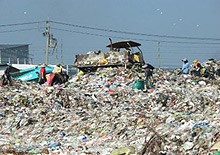- Waste management in Japan
- Circular economy in Japan
- Waste management in Asia
- Disaster waste management
Evaluation of Constructed Wetlands at a Waste Landfill Site in Thailand
We are currently (as of October 2014) engaged in a research project on evaluating feasibility of applying Constructed Wetlands (CWs), a waste landfill leachate treatment technology, in Southeast Asian countries with a view to improving their landfill management (see also our article on CWs in the February 2013 issue [in Japanese]). For that purpose, we have installed CWs at a waste landfill site in Thailand. This article introduces current situation at the site and how we prepared and installed the CWs to start their operation.
Evaluation of CWs at a landfill site outside Japan
When introducing a new technology to landfill sites outside Japan, we need to evaluate the technology beforehand in the field and make necessary adjustments and improvements. This is especially true in the case of biological wastewater treatment technologies as their performances are highly dependent on temperature and other local climatic conditions as well as quality of the wastewater to be treated. Since sustainable operation of such technologies in Southeast Asia requires fine tuning under actual local conditions, we also paid special attentions to local technical capacity and applicability of local materials/equipment and verified them through our experiment.
In 2012, the Center for Material Cycles and Waste Management Research established a collaborative research hub in Bangkok with King Mongkut's Institute of Technology and Kasetsart University. In our research project on CWs, we have been collaborating mainly with Kasetsart University to evaluate applicability of CWs at a waste landfill site in Sai Noi District in Nonthaburi Province, some 40 km northwest of Bangkok. When establishing policies on our research activities and deciding a site to install CWs, we also consulted with Nonthaburi provincial government that manages landfill sites.
Situation at the Sai Noi landfill site

The waste from Nonthaburi Province is directly landfilled at the Sai Noi District site. It is mainly composed of kitchen waste, plastics, paper and yard waste (grass and trees). At the site, many waste pickers retrieve recyclable materials from waste piles to sell them for their livelihood. Children walk barefooted, and birds and feral dogs search for food (Fig.1). The Sai Noi and many other landfill sites in Southeast Asia lack reliable power supply, and they can use little electricity. A wastewater treatment technology using a combination of coagulation/flocculation/sedimentation and membrane treatment processes was once introduced to the Sai Noi landfill site as part of Japan's official development assistance, but it is no longer in use due to financial difficulties of running and maintaining the technology. The landfill site collects leachate in an artificial pond (reservoir) and treats it there only by natural evaporation and purification. Even Thailand, one of the frontrunners toward economic development in Southeast Asia, has a long way to go before it achieves a sufficient level of landfill site management.
Installation of pilot-scale CWs
In view of this situation in Southeast Asia, we prepared and installed pilot-scale CWs with the aim of promoting applications of leachate treatment technology that can be easily introduced and operated with locally available materials and equipment.
First, we built a concrete tank (1 m [width] x 2 m [length] x 1 m [depth]) and placed a polyvinyl chloride (PVC) pipe at the bottom as an outlet pipe. The PVC pipe and the tools we used were locally available ones. We then filled the tank with sand and gravel and planted some plants. This completed the pilot-scale CW installation. A large-size planter like this can be easily made by anyone. The important point, however, is selecting plant species and the CW's operation conditions. The leachate at the Sai Noi landfill site showed characteristics of low concentrations of organic matter, nitrogen and phosphorus. By contrast, it showed high salinity, so high that it may even destroy the plants that are less resistant to salt. Our preliminary evaluations confirmed that cattail that was growing wild in the surrounding area can survive and grow in the leachate. Thus, we planted this native cattail species in the CWs. In Thailand, cattail grows on the roadside and vacant lots, and it can be easily obtained and maintained. There is no need of specially procuring it for the CWs. This is a big advantage.

Toward sustainable leachate management
As mentioned earlier, installation of the CWs is not difficult. However, we still have a question whether the introduction of this technology can really improve landfill leachate management in Southeast Asia. Types of substances that a CW can remove from wastewater and its removal performance depend on operation conditions including water level, flow pattern as well as the loading rate of these substances. In other words, if we understand and control these parameters well, application of the CWs can successfully realize sustainable leachate management at the landfill sites in Southeast Asia in the long term. Therefore, our current research focuses on clarifying these operation conditions (see a relevant article on application of CWs in Southeast Asia in the March 2014 issue).
For more information
- Ogata Y., Ishigaki T., Ebie Y., Sutthasil N., Chiemchaisri C., Yamada M. (2015) Water reduction by constructed wetlands treating waste landfill leachate in a tropical region. Waste Management, 44, 164-171
- Ogata Y., Ishigaki T., Ebie Y., Yamada M. (2017) Applicability Evaluation of Constructed Wetlands for Landfill Leachate Treatment in Thailand (2017) Journal of Environmental Conservation Engineering, 46 (11), 596-600 (in Japanese)
- Ogata Y., Ishigaki T., Ebie Y., Sutthasil N., Witthayaphirom C., Chiemchaisri C., Yamada M. (2018) Design considerations of constructed wetlands to reduce landfill leachate contamination in tropical regions. Journal of Material Cycles and Waste Management, 20 (4), 1961-1968
- Witthayaphirom C., Chiemchaisri C., Chiemchaisri W., Ogata Y., Ebie Y., Ishigaki T. (2020) Long-term removals of organic micro-pollutants in reactive media of horizontal subsurface flow constructed wetland treating landfill leachate. Bioresource Technology, 312, 123611


